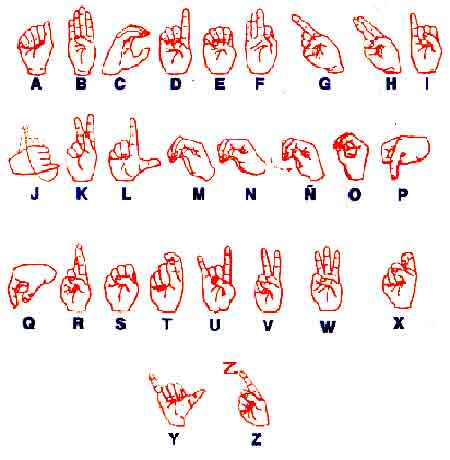This is a translation of the post HOW THE PERSON CAN LEARN TO COMMUNICATE
TALKING TO OTHERS.
![]()
A person who loses the ability to hear can not hear himself when he speaks. Because of this, the tone of your voice and the way it is expressed can change. The tone of your voice
It can become very high or very low, very acute or very serious. You can also say some words
incorrectly.You can help her to continue speaking clearly. For example, if you speak too low, by your hand behind your ear to show that you can not hear it.
If the person speaks very loudly, you can put a finger over your lips or hands over your ears.
If you use words incorrectly, let them know that what you are doing is not correct. Make sure the person looks at you. Say the words she said incorrectly. Ask him to repeat the words. Let him know when he says them correctly.
LEARNING THE MEANING OF THE MOVEMENTS OF THE FACE.

Maybe the person can understand some of the things you say looking at the movements of your face and lips while you talk. This is what is called lip reading.
If you can hear loud sounds, you may hear some of the words and read the lips at the same time to understand the rest.
Ask if you can hear better by placing a hand behind your ear. Let her try this with each ear to find out if it helps. The person can never read all the words you say. This is because for some different sounds, the lips move in the same way. For example, we make the same movements with the lips when we say "mom" and "dad".
Sometimes, you will not be able to read the movements of your lips, but you will be able to understand some of the expressions on your face.
Some people learn to read lips even when they are never taught to do so.
Not all people can read lips. Remember that this is a
ability.Spend some extra time each day to help the person learn to read your lips while you talk to him.
The person must see your face. Sit or stand in the light. Speak clearly Do not move your lips any more than you move them when you talk to other people. Do not talk with something in your mouth.
Start with words that you and your family use every day. For example, you can show him the things you bought in the market. Point to the tomatoes with a finger and say "I bought tomatoes." Do the same with everything you've bought.
Then say the same thing without indicating the objects, naming them in a different order. For example, if you named tomatoes, rice and corn in that order the first time, now I gave corn, tomatoes, rice. Ask the person to repeat what you say.
Start with a few words. When the person can do the lip reading of these words, add some new ones. In this way, you will help the person understand you by reading your lips.
Talk to the other person about people or events that interest them. Perhaps the person wants to know about family members and their activities, or other members of the community and what they do.
You, other family members and friends should talk with the person as often as they did before the person lost the hearing.
Explain to others that they should be facing the person when they speak to him, in addition to doing so clearly. Also tell them that the expressions on their faces will help you understand what they say.
READING

If the person can read, you may like to read newspapers, magazines or books. This will help you know what happens in the community. It will also give you topics that you can discuss with other people.
You, like other people, can have newspapers, magazines or books and give them to the person who has difficulty hearing. In your community, or near him or her, there may be a library to which the person may also attend.
If the person can read, you can also communicate by writing on a piece of paper what you want to say, or spelling words with your fingers. You can use your fingers to form letters and spell words, so that you can understand those people who have trouble reading their lips.
You should also find out other ways to communicate with the person. If she gets information when reading or spelling words with her fingers, she may not be able to communicate with people who can not read. Every day, she spends time helping her learn to communicate. Proof
different ways for the person to communicate.Teach what you want to learn. Do not force the person.
Teach the person for short periods of time, allowing them to rest.
Teaching her three times a day will give better results than helping her for a long time each day.
FORM EACH LETTER IN THE ALPHABET. THESE EXAMPLES ARE SHOWN TO
CONTINUATION. IF IN YOUR ÍS OR REGION IS USED ANOTHER ALPHABET, YOU CAN CREATE MOVEMENTS WITH YOUR FINGERS THAT SUIT THE TUALFABETO.
VENEZUELAN SIGN ALPHABET

When you are talking to the person, use the movements of the face, hands and body to help you understand what you say
The different expressions of your face will help you to read the lips
The movements of your hands and body can also help the person understand what they can not grasp by reading your lips
You can use a determined movement of your hands to indicate a word or an idea. Every time you want the person to understand that word or idea, use the same movement
When a person uses their hands to make certain movements that mean certain words or ideas, the person is, in fact, using sign language.
IN VENEZUELA WE HAVE THE VENEZUELAN SIGN LANGUAGE

Find out if there are any people in your community who already know that language. Maybe that person can come and teach you, and other people
You, the family members and the friends of the person must learn the signs together with her. They must use signs to exchange information with the person
Maybe people can talk. In this case, you do not need to use signs to give information to other people. But you must know sign language to get information from other people.
You can teach sign language as follows: Choose a sign you want to teach. For example, you may want to learn the sign to "come". Talk to the person at the same time you use the sign. For example, say "come with me." Make the sign to "come" while you say the word. If you have trouble reading your lips, show signs for the words you use most often. Family and friends must know the same signs to be able to communicate with the person. If you do not understand, ask a family member for help. This one can be stopped near the person. Make the sign to "come" and tell the relative and the person, "come with me." Then, the family member should walk towards you to show the person what your words and sign mean
Some people who can not hear may not want to learn sign language. If this is the case, do not force the person. Continue to communicate with the person in a way that she wants to use.
Congratulations! This post has been upvoted from the communal account, @minnowsupport, by zhother from the Minnow Support Project. It's a witness project run by aggroed, ausbitbank, teamsteem, theprophet0, someguy123, neoxian, followbtcnews/crimsonclad, and netuoso. The goal is to help Steemit grow by supporting Minnows and creating a social network. Please find us in the Peace, Abundance, and Liberty Network (PALnet) Discord Channel. It's a completely public and open space to all members of the Steemit community who voluntarily choose to be there.
Downvoting a post can decrease pending rewards and make it less visible. Common reasons:
Submit